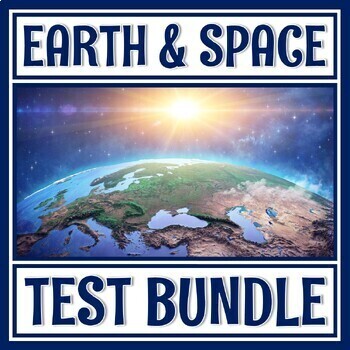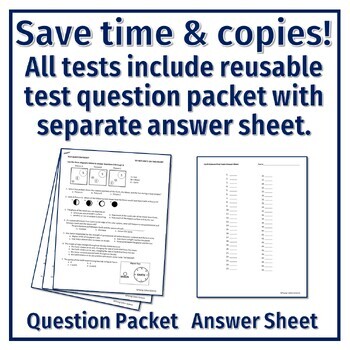Earth Science Test BUNDLE FULL YEAR NGSS MS-ESS
- Zip
Products in this Bundle (9)
showing 1-5 of 9 products
Also included in
- SAVE MORE THAN 25%! This bundle contains every NGSS-based Earth and Space Science quiz and test offered by Flying Colors Science. Get kids THINKING! Each assessment reflects the intended rigor of the Next Generation Science Standards by including questions that are much more than "definition styPrice $49.99Original Price $78.15Save $28.16
- Never search for "something to do tomorrow" ever again! This bundle contains PRINT AND GO lessons, NO PREP activities, LOW PREP labs, and ENGAGING articles to supplement and thoroughly enhance an Earth and space science course. Every included resource is easy to implement, standards-based, and high-Price $399.99Original Price $639.06Save $239.07
Description
SAVE MORE THAN 25% with this set of 9 middle school Earth and space science tests for every unit of the year!
⭐ YOUR WORK IS DONE! This an entire year of summative assessments designed for 6th, 7th, and 8th-grade NGSS-aligned Earth and space science classes.
⭐ Get kids THINKING! The tests in this collection are more than "definition style" exams! Each includes some application of knowledge (at the middle school level) of each topic and contains simple diagrams, charts, or graphs to analyze. In this way, questions mimic NGSS-based standardized tests.
⭐ SAVE CORRECTING AND COPYING TIME! Less copies and easy to correct - save time with our test packet format! All assessments included have a test question packet and a separate answer sheet. Test Question Packets can be reused again and again as a class set without recopying. And, all student answers are on one page so it's a breeze to correct!
Includes the Following NGSS-Based Tests:
- Moon & Tides
- Earth's Motions & Seasons
- Earth's History
- Weathering, Erosion & Rock Cycle
- Plate Tectonics
- Water Cycle
- Weather
- Climate Change
- FINAL EXAM
Teacher Notes:
- ALL ANSWER KEYS INCLUDED!
- Please note that these resources are not editable.
We also offer:
Full Year PHYSICAL SCIENCE Tests Bundle
Full Year LIFE SCIENCE Tests Bundle
⭐⭐⭐ Click here to get 5 FREE EARTH & SPACE SCIENCE lessons! ⭐⭐⭐







